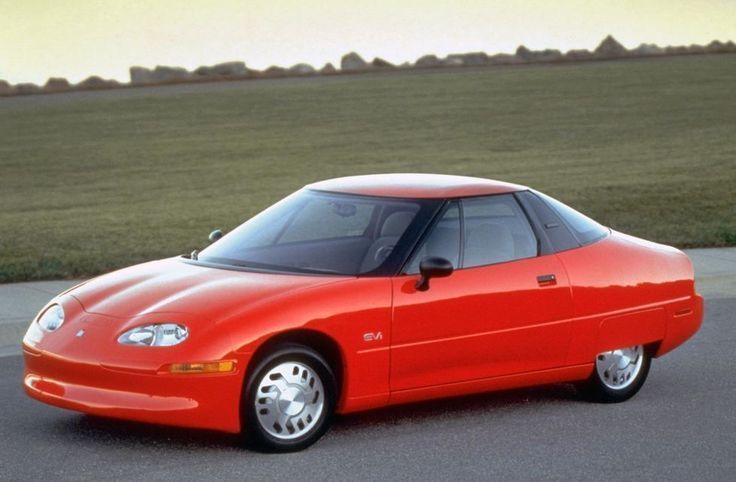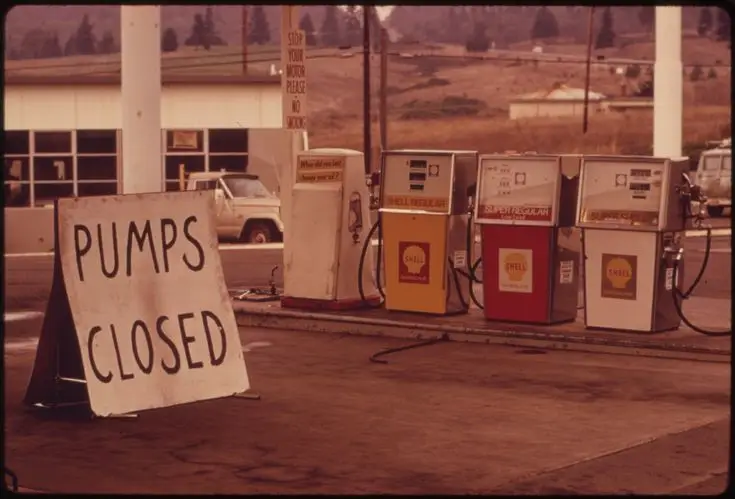Cars and fuel have had a complicated relationship since the early days of automobiles. When cars first hit the road, few people worried about gas prices or efficiency. That changed dramatically in the 1970s when the oil crisis forced automakers to rethink their designs. The oil shortages of the 1970s sparked interest in electric vehicles and pushed car manufacturers to develop smaller, more fuel-efficient models that would forever change automotive design.

This shift wasn’t just about making cars that used less gas. It was the beginning of a revolution in how we think about transportation. Car companies started experimenting with aerodynamic shapes, lighter materials, and alternative power sources. The 1970s oil crisis didn’t just lead to temporary changes – it started a long journey toward the electric vehicles we see today.
What started as a response to fuel shortages has evolved into something much bigger. Environmental concerns, technological advances, and changing consumer preferences have all played a role in pushing car design from gas-guzzling machines to the sleek, efficient, and increasingly electric vehicles that are transforming our roads today.
Key Takeaways
- The 1970s oil crisis forced automakers to prioritize fuel efficiency, leading to smaller cars and early electric vehicle experiments.
- Environmental concerns and emissions regulations have progressively shaped more sustainable vehicle designs over the decades.
- Consumer preferences have shifted toward valuing both efficiency and performance, accelerating the current electric vehicle revolution.
From Oil Beginnings to Fuel Crises

The automobile industry’s relationship with oil has shaped vehicle design, transportation patterns, and global politics for over a century. This evolution from early adoption to crisis points transformed how we think about cars and their energy sources.
The Rise of the Internal Combustion Engine
The internal combustion engine revolutionized transportation in the late 19th century. Early vehicles like the Ford Model T, introduced in 1908, made automobile ownership accessible to average Americans for the first time.
These engines relied primarily on gasoline, a petroleum product that became increasingly available as oil production expanded. By 1920, there were over 8 million passenger cars in the United States alone, creating massive demand for fuel.
Diesel engines, developed by Rudolf Diesel in the 1890s, offered an alternative that was more efficient but still petroleum-based. These engines became popular for commercial vehicles and trucks due to their durability and lower fuel consumption.
The discovery of cheap Texas crude oil helped solidify gasoline as the dominant fuel source, pushing early electric vehicles out of the market by the 1930s.
Influence of Oil on Car Design and Mobility
Abundant, low-cost oil enabled dramatic changes in car design. Vehicles became larger and more powerful as fuel efficiency wasn’t a primary concern.
American cars of the 1950s and 1960s featured large V8 engines, extensive chrome, and substantial weight – all reflecting an era of cheap gasoline. This period saw the rise of the “muscle car” with its focus on power rather than efficiency.
Oil availability also revolutionized personal mobility. Suburbs expanded as commuting by car became feasible for millions of workers. Highway systems grew, with the U.S. Interstate Highway System beginning construction in 1956.
Fuel prices directly influenced car aesthetics and engineering, with manufacturers responding to consumer preferences shaped by oil abundance.
Historical Oil Crises and Their Impact
The 1973 OPEC oil embargo shocked the automotive world. Oil prices quadrupled, causing fuel shortages, rationing, and long lines at gas stations. American automakers, focused on large vehicles, were unprepared for the sudden demand for fuel-efficient cars.
Japanese manufacturers like Toyota and Honda, already producing smaller, more efficient vehicles, gained significant market share. This crisis pushed U.S. Congress to implement the first Corporate Average Fuel Economy (CAFE) standards in 1975.
The 1979 energy crisis, triggered by the Iranian Revolution, caused another spike in oil prices. This second shock accelerated interest in alternative vehicles, including early electric car conversions of gasoline vehicles.
These crises permanently altered automotive design, pushing manufacturers toward aerodynamic shapes, lighter materials, and more efficient engines to reduce oil consumption.
Environmental Concerns and Pollution Regulations

As cars became more widespread throughout the 20th century, their environmental impact grew into a major global concern. The harmful effects of vehicle emissions led to increasingly strict regulations and pushed manufacturers to develop cleaner technologies.
California Air Resources Board and Emissions Standards
The California Air Resources Board (CARB) emerged as a pioneering force in combating vehicle pollution. Established in 1967, CARB set emissions standards that often exceeded federal requirements, forcing automakers to develop cleaner vehicles.
These strict regulations dramatically changed how cars were designed. Catalytic converters and improvements in engine design became standard features as manufacturers worked to meet California’s tough standards.
By the 1990s, CARB introduced the Zero-Emission Vehicle (ZEV) mandate, requiring automakers to sell a percentage of electric vehicles. This bold move helped spark early interest in electric cars, well before they became mainstream.
Many states eventually adopted California’s stricter standards, effectively creating two sets of emissions regulations in the US and compelling manufacturers to build cleaner vehicles nationwide.
Global Warming and the Push for Cleaner Alternatives
Rising concerns about climate change in the late 20th century put vehicle emissions under intense scrutiny. Cars were identified as major contributors to carbon emissions and global warming, prompting calls for cleaner alternatives.
The discovery of cheap Texas crude oil had previously contributed to the decline of early electric vehicles by 1935. However, growing environmental awareness reversed this trend decades later.
While electric vehicles have become a key solution, they aren’t perfect. Manufacturing EVs produces significant emissions, with the carbon footprint varying based on where batteries are produced.
The electricity mix powering EVs also matters greatly. In regions relying heavily on coal power, the environmental benefits of electric vehicles are reduced compared to areas with cleaner energy sources.
Technological Advances Influencing Car Design

Innovations in materials and energy storage have dramatically reshaped vehicle design since the oil crisis of the 1970s. These technological breakthroughs have enabled manufacturers to create more efficient vehicles while maintaining performance standards.
Shift to Lightweight Materials
The pursuit of fuel efficiency has transformed automotive construction materials. Manufacturers replaced heavy steel components with aluminum, carbon fiber, and high-strength composites to reduce vehicle weight.
This material evolution began after the 1970s oil crisis when automakers sought ways to improve mileage ratings. A 10% reduction in vehicle weight typically delivers a 6-8% improvement in fuel economy.
Modern vehicles now incorporate aluminum body panels, carbon fiber reinforced polymers in structural components, and high-strength steel alloys. These materials maintain safety standards while significantly reducing overall mass.
Aerodynamic designs complement these lightweight materials. Sleeker profiles with lower drag coefficients further enhance efficiency, resulting in the distinctive rounded shapes common in contemporary vehicles.
Breakthroughs in Energy Storage Systems
Advanced energy storage technologies have revolutionized automotive design possibilities. The development of lithium-ion batteries has been particularly transformative for electric vehicle architecture.
Early electric vehicles following the oil crisis were limited by heavy, inefficient lead-acid batteries. Today’s lithium-ion systems offer 5-7 times greater energy density, enabling longer ranges and faster charging.
This evolution has freed designers from traditional engine compartment constraints. Electric powertrains allow for:
- Flat “skateboard” chassis designs
- More flexible interior space allocation
- Smaller cooling systems
- Front trunk (“frunk”) storage areas
Battery placement in floor panels has lowered the center of gravity in modern EVs, improving handling characteristics. The compact nature of electric motors compared to internal combustion engines has also created new design opportunities.
Alternative Fuels and Renewable Energy Sources

The pursuit of cleaner alternatives to petroleum has dramatically influenced vehicle design and engineering. Today’s transportation sector explores multiple pathways beyond traditional gasoline and diesel fuels.
Evolving Landscape of Biofuels and Biodiesel
Biofuels emerged as early alternatives to petroleum, utilizing renewable organic materials instead of fossil fuels. The ethanol revolution in Brazil demonstrated how nations could reduce oil dependence through agricultural resources.
First-generation biofuels like corn ethanol and soybean biodiesel paved the way for today’s advanced biofuels. These newer alternatives use non-food crops and waste materials, reducing competition with food production.
Biodiesel has gained traction for its compatibility with existing diesel engines. Many trucks and heavy equipment now run on B20 (20% biodiesel blend) with minimal modifications.
Vehicle manufacturers have responded by developing flexible-fuel vehicles capable of running on various alternative fuel blends. This adaptability represents a significant shift in design philosophy.
Electricity and Hydrogen as Emerging Fuel Alternatives
Electric vehicles represent a return to automotive history rather than a new invention. Early 1900s electric cars were popular until cheap oil and improved roads favored gasoline engines.
Today’s EV renaissance features dramatic design changes. Without internal combustion engines, vehicles can utilize:
- Expanded interior space
- Lower centers of gravity
- Novel cooling systems
- Regenerative braking technology
Charging infrastructure has become a critical design consideration, with manufacturers developing solutions for faster charging and longer ranges.
Hydrogen fuel cell vehicles represent another promising alternative. These vehicles generate electricity onboard through hydrogen and oxygen reactions, emitting only water vapor as exhaust.
Currently, more than a dozen alternative fuels are in production or development for advanced vehicles, each requiring specific design considerations and engineering solutions.
The Electric Vehicle Revolution

Electric vehicles have evolved from niche experiments to mainstream transportation options, driven by technological advances and changing attitudes toward fossil fuels. Their development represents one of the most significant shifts in automotive design since the internal combustion engine.
Early Pioneers: The GM EV1 and Chevrolet Volt
General Motors made automotive history with the EV1, the first mass-produced electric vehicle from a major manufacturer in the modern era. Released in 1996, the EV1 featured an aerodynamic design specifically engineered to maximize battery range.

Despite its technological achievements, GM ultimately canceled the EV1 program in 2003, citing limited battery technology and insufficient consumer demand. All but a few vehicles were crushed, creating controversy among early adopters.
Years later, GM returned to electrification with the Chevrolet Volt in 2010. Unlike the pure-electric EV1, the Volt featured a plug-in hybrid design with a gasoline generator to extend range, addressing the “range anxiety” that plagued earlier electric vehicles.

The Volt represented a transitional approach, offering electric driving for daily commutes while maintaining the flexibility of gasoline for longer trips.
Infrastructure and Challenges in Electric Car Adoption
Charging infrastructure remains one of the biggest hurdles for widespread electric vehicle adoption. Early adopters often faced a sparse network of charging stations, limiting long-distance travel capabilities.
Recent years have seen significant expansion of charging networks, with fast-charging stations capable of providing 80% battery capacity in 30 minutes. However, rural areas and apartment dwellers still face accessibility challenges.
Battery technology has improved dramatically, with costs dropping 89% since 2010 while energy density has increased. Modern electric vehicles now commonly offer 250+ miles of range, addressing one of the primary concerns of potential EV buyers.
Consumer preferences continue to evolve, with increasing interest in EVs driven by lower operating costs, reduced maintenance requirements, and environmental benefits. However, higher upfront costs still deter many buyers despite long-term savings.
Electrification of Mobility and the Role of Cities
Cities have become crucial testing grounds for electric mobility solutions beyond personal vehicles. Electric buses, delivery vans, and shared mobility services are transforming urban transportation networks.
Many metropolitan areas have implemented policies to encourage EV adoption, including dedicated lanes, preferred parking, and emission-free zones. These measures aim to reduce air pollution and noise in dense urban environments.
The oil crises of the 1970s sparked early interest in electric alternatives, but today’s momentum comes from climate concerns and technological feasibility. Cities now recognize that building electrification and transportation electrification must work together.
Integrated approaches connecting vehicles to buildings through vehicle-to-grid technology allow EVs to serve as mobile energy storage, potentially stabilizing electrical grids and enabling greater renewable energy integration.
The Impact of Policy and Consumer Preferences

Policy decisions and shifting consumer attitudes have dramatically shaped the evolution of vehicle design, especially in response to fuel concerns. Market forces and environmental awareness continue to drive innovation in the automotive industry.
Government Incentives and Industrial Innovation
Government regulations on fuel efficiency and exhaust emissions have strengthened the position of electric vehicles in the market. Following the 1970s oil crisis, many nations began implementing policies to reduce dependence on fossil fuels.
These policies include tax credits, rebates, and direct subsidies for electric vehicle purchases. In some regions, manufacturers face penalties for failing to meet fleet-wide efficiency standards.
Industrial innovation has accelerated in response to these policies. Auto manufacturers have invested billions in research and development of electric drivetrains, battery technology, and lightweight materials.
The interplay between policy and innovation creates a feedback loop. As technologies improve, governments often raise standards further, pushing companies toward even greater efficiency.
The Shift in Market Demands and Ecological Awareness
Consumer preferences have evolved significantly, with high fuel costs becoming the top motivator for electric vehicle purchases. Over 55% of potential buyers cite fuel expenses as their primary reason for considering EVs.
Beyond economics, ecological awareness has reshaped buying habits. Climate change concerns and awareness of environmental damage from fossil fuels influence purchasing decisions more than ever before.
Research into consumer motivations for EV purchases shows complex factors beyond price. Status considerations and environmental values play significant roles in the decision process.
Car designs now prominently feature eco-friendly materials and highlight efficiency metrics. Manufacturers showcase their environmental commitments in marketing materials, responding to consumer demand for sustainability.
Frequently Asked Questions

The oil crisis of the 1970s and subsequent developments in vehicle technology sparked significant changes in automobile design and engineering. These events reshaped how manufacturers approached efficiency, aerodynamics, and alternative fuel sources.
What were the key design changes in cars due to the oil crisis?
During the 1970s oil crisis, automakers quickly shifted toward smaller, more efficient vehicles. Large, gas-guzzling cars gave way to compact designs with better aerodynamics.
Engineers focused on reducing vehicle weight by using lighter materials and smaller engines. Cars became more streamlined with lower drag coefficients to cut through the air more efficiently.
Many manufacturers introduced fuel efficiency technologies like front-wheel drive, which allowed for more interior space while keeping vehicles compact. Electronic fuel injection systems replaced carburetors to optimize fuel consumption.
How did the advent of electric vehicles influence automobile engineering?
Electric vehicles revolutionized automotive design by eliminating the need for traditional engine compartments. This allowed for more flexible interior layouts and storage options.
Engineers developed regenerative braking systems that convert kinetic energy back into electricity, improving efficiency. Battery placement became a crucial design element, often integrated into the floor for better weight distribution and handling.
EV designs also prioritized aerodynamics even more than conventional vehicles to maximize range. The absence of exhaust systems and complex transmissions simplified many aspects of vehicle design.
Who is credited with designing the first fully electric car?
Thomas Parker, an English inventor, is often credited with creating the first practical electric car in 1884. His design used rechargeable batteries and was among the earliest electric vehicles to achieve practical use.
Earlier attempts at electric transportation date back to the 1830s, with Scottish inventor Robert Anderson developing a crude electric carriage. Hungarian inventor Ányos Jedlik created a small model car powered by an electric motor in 1828.
These early pioneers laid groundwork for later innovators, though no single person can claim exclusive credit for inventing the electric car. The technology evolved through contributions from multiple inventors across different countries.
When was the first modern electric car introduced to the market?
The General Motors EV1, introduced in 1996, is widely considered the first modern production electric car from a major manufacturer. It was available through a limited lease program in California and Arizona.
However, the 1990s saw several other electric vehicle attempts, including the Toyota RAV4 EV and Honda EV Plus. These early modern EVs had limited ranges of 70-100 miles per charge.
The true mainstream breakthrough came with the Tesla Roadster in 2008, which proved electric cars could be both high-performance and desirable consumer products.
Why did gasoline-powered vehicles become more popular than electric ones in the early 20th century?
Gasoline vehicles gained dominance largely due to the discovery of cheap, abundant oil in Texas and the introduction of the Ford Model T in 1908. Mass production made gasoline cars more affordable than their electric counterparts.
Electric vehicles of that era suffered from limited range and long recharging times. The expanding road network connecting cities required vehicles that could travel longer distances without stopping.
Charles Kettering’s invention of the electric starter in 1912 eliminated the difficult hand-cranking of gasoline engines, removing one of the few remaining advantages electric cars held.
Is the current electrical infrastructure capable of supporting a mass transition to electric vehicles?
Most developed countries need significant grid upgrades to support widespread EV adoption. Current electrical infrastructure can handle gradual transition, but mass adoption would strain existing systems.
Smart charging technologies are being developed to balance load demands by charging vehicles during off-peak hours. Some regions are implementing grid storage solutions using renewable energy to supplement power during high-demand periods.
Distributed energy generation through home solar systems and neighborhood microgrids may help reduce centralized grid pressure. As more drivers choose electric vehicles, utilities are planning strategic infrastructure investments to meet future power demands.



